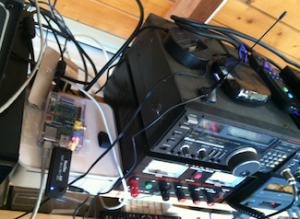*rPlay is a way to turn you Raspberry Pi in the an airplay device. Since it is still a beta version you might come into multiple issues when playing video or audio. If it does not work, restart the Pi or back track and see if you missed anything when setting up the device.
license key: S1377T8072I7798N4133R (you need to enter this in step 4, make sure no spaces are entered)
Requirements:
Your Pi device needs to have Internet access.
No X Windows environment is required. rPlay runs on a dumb terminal.
Instructions:
(1) update firmware: (you may skip this step, and perform the rest first, if not working well, then do this)
sudo apt-get install rpi-update
sudo rpi-update
(2) allocate more memory to GPU
sudo raspi-config
then select memory_split, change the value to 256 if you have a Model B device, or 64 or 128 if you have Model A device.
(3) prepare dependencies, run the following command on Pi
sudo apt-get update
sudo apt-get install libao-dev avahi-utils libavahi-compat-libdnssd-dev libva-dev youtube-dl
sudo youtube-dl –update
(4) download, install and run
sudo dpkg -i rplay-1.0.1-armhf.deb
this will install and launch /usr/bin/rplay, and it runs automatically on boot.
you can try to reboot your Pi at this point, and rplay should auto start after reboot. No need to do step (5).
(5) manual start and stop
sudo /etc/init.d/rplay start (NOTE, DON’T start this after step 4, step 4 auto starts rplay, if you have 2 instances of rplayrunning, none would work!)
sudo /etc/init.d/rplay stop
if you want to see the output message, you can run this way:
sudo /user/bin/rplay
Make sure only one instance is running.
(4) THIS IS VERY IMPORTANT, enter the license key, without it, AirPlay mirroring won’t work
Safari browser has problems, try to use other ones.
once rplay is running, go to a browser and open this url:
http://<ip-address-of-pi>:7100/admin
or
the username/password is: admin/admin
go down to the last one, enter the license number, click Submit.
You can also perform other admin tasks here, such as setting password, toggling fullscreen, recording, etc.
the config file is /etc/rplay.conf, you can also manually edit the config file, instead of using the web interface. Append license_key=<your-license-key>
to the last line of the file, for example:
admin_password=admin
password=
onscreen_code=0 [or 1]
fullscreen=0 [0r 1]
license_key=1223dd-your-from-email
(5) test regular AirPlay and AirPlay Mirroring
rPlay supports AirPlay and AirPlay Mirroring. For iphone 4 and iPad 1, you can’t do AirPlay mirroring, but you should be still
do AirPlay for Photos/Music/Videos. For iPhone 4S and iPhone 5, iPad 2 and above, you can also do AirPlay mirroring.
on your iOS devices, double click Home button, slide to the most left, and choose rPlay as AirPlay device to connect.
for iOS 7, you need to quickly swipe up from the bottom to bring up AirPlay window, and choose rPlay as AirPlay device to connect.
(6) test Chromecast
you need to install and update youtube-dl on pi, run the following command on Pi to auto update it:
sudo apt-get install youtube-dl
sudo youtube-dl –update
right now, this is very simple implementation, it only works with YouTube app, either on Android or iOS.
make sure you download the latest YouTube app on your mobile device, then open YouTube app, pick a video to play, on the top right corner,
there will be a square chromecast button, tap it, and choose rPlay to connect.
the video should play on Pi, it won’t be able to control with this version, we will improve it.
(7) uninstall rplay
sudo /etc/init.d/rplay stop
sudo dpkg -r rplay
(8) You are more than welcome to create videos on rPlay, and I’d appreciate if you can spread the words and promote our software.
(9) If rplay is not found by your devices, you can try to toggle WIFI on your devices, turn it off and then on. You may also power off your router
then power it on.







